 United Kingdom (1958) – HMS Porpoise, Rorqual, Narwhal, Grampus, Finwhale, Cachalot, Sealion, Walrus 1957-91.
United Kingdom (1958) – HMS Porpoise, Rorqual, Narwhal, Grampus, Finwhale, Cachalot, Sealion, Walrus 1957-91.After exploring the A class (Amphion), last WW2 British design and first streamlined for a longer career in the cold war, here is the first generation cold war conventional submarine, designed and built from the ground up for the Royal navy: The Porpoise class. The idea was to order eight-boat diesel-electric patrol submarines capable of roaming the sea lanes in the Empire. However as the economic and geopolitic context changed, they became attack submarines. First design to be built after the end of World War II, they were in many ways influenced by the Type XXI U-boats, of which Britain obtained one example, U-3017. Built in 1956-59 they stayed active until the 1980s, soon to inspire the all-improved Oberon class. #coldwar #porpoise #submarine #UboattypeXXI #attacksubmarine #dieselelectric
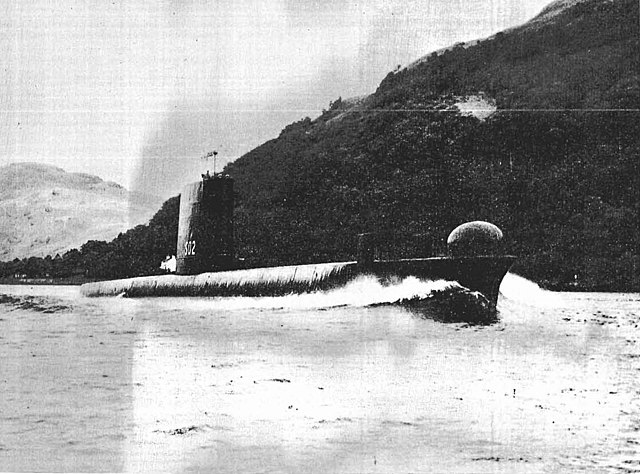
HMS Rorqual S02 underway 1964
Development
HMS N41: The influence of the Type XXI

The German “wunderwaffe” (or bragged as such) in 1944 Germany concentrated so many innovations that indeed it took a radical departure from all designs of the time and if realized the right way and in the right numbers, under the right conditions could have indeed turned the tables of the Battle of the Atlantic, despite the crushing numerical and tactical superiority in ASW warfare developed by the allies late in the war. However in many construction aspects and technical compromises and delays, this program never achieved much, with too few submarines active to make a difference at the end of the war. It did not prevented a race between major powers to acquire German tech after the end of hostilities, smuggling plans and scientists. In the naval realm, the Type XXI U boats were probably among the most coveted prizes, and an allied commission gathered every surface ships or submarines at Wilhelmshaven to decide their fate and attribute war reparations.
Great Britain obtained several sgips and subamrines, but focused on U-3017. The three innovations which were all considered with great interest were its Snorkel (and old idea developed by the Dutch but perfected in Germany). In practice in heavy weather this was not great, as experienced by GUPPY’s crews in the 1950-60s.The second innovation came from one of the protypes with a Walter turbine, envisioned at first for the Type XXI. This was also considered with great interest and later led to design two experimental subs, the Explorer class. Evaluation concluded these early AIP systems were too risky and unreliable for combat.
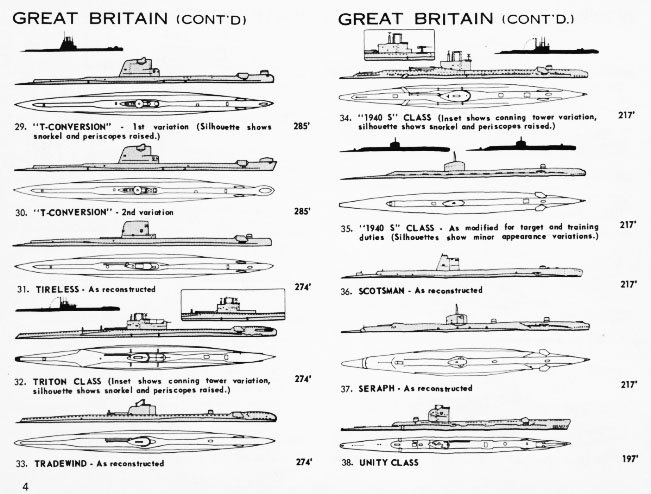
Early postwar Britsh subs, ONI Submarine Sighting Guide Revision 1 ONI 31SS-Rev. 1
The third innovation was the combination between a massive electrical output for greater underwater speeds as a simple and reliable solution but requiring a deeper hull, and a well streamlined one. While testing the war prize TU-3017, commissioned into the Royal Navy as HMS N41, the commissioned concluded that all existing escorts would have issues finding and depht charging a sub racing at 17 knot indeed. In fact an early GUPPY, USS Odax, managed to outrun a destroyer escort several times, proving the concept.
There were other innovations such as an automated reloading system, better sonar, better radars, automated AA defence even including rockets, a fully modular contruction for quick assembly and “8” shaped pressure hull, but they were considered less imprortant. Until reliable long-range sonars such as the US SQS-4 and equivalent came about these types of submarines could indeed roam the seas with impunity. More so, both France and USSR obtained those Type XXI and were as much influential. After the “fall of the iron curtain” as started by Churchill in 1947, Staling wanted Type XXI near copies in huge numbers (Project 613 or NATO Whiskey) and it very much shaped the ASW tactics of the west for decades.
HMS N41 was used for extensive tests until being scrapped during November 1949. The technical staff evacuating her found the model more practical in intermediate speeds and underwater endurance at low speed rather than systematic high speed. They also considered increased torpedo performance to attack from beyond sonar range, and started working on a torpedo which had triple the range and speed as before, as well as homing and pattern-running torpedoes. Periscope ranging radars for torpedo fire control and better scopes were also looked upon.

HMS Artful as modernized
The Royal Navy concluded that a 15-knot underwater speed was not improving survivability anyway, partly based on their own WW2 experience. They estimated a sub would be detected anyway and that being able to deliver homing torpedoes was the best way to deal with a threat. The first concrete result was to integrate the snorkel on ll subs, improve it but only used in the right weather conditions. The “A” or Amphion class, still under construction by late 1944 were planned for improvements learned from HMS N41, and HMS Truant in 1945 of the 1937 T class III batch was used as prototype, with improvements later retrofitted on the entire “A” class and upgrading surviving T class, which became in the 1950s the “T streamlined”: Talent, Token, Tireless, Tapir and Teredo were completely rebuilt and served until 1970.
The programme proceeded rapidly after the war for an improved “A” class designed with relatively minor change initually until modified in July 1945 by Flag Officer Rear Admiral George Creasy which wanted an equivalent of the XXI, with a large battery capacity combined to a snort and refined streamlining, no deck gun and new fin. Many oped also to use a more reliable British version of the Walter turbine. The A class were modernized in the 1950s and stayed in service until the mid-1970s but they were essentially considered as a stopgap, to make in numbers while nex designed from the ground p were worked on. This led to the postwar Porpoise class, closer to the original Type XXI. HMS N41 after achieving its purpose was eventually discarded in 1949 and BU.
Design development of the Porpoise class
While the Explorer class tested an AIP, the HTP or hydrogen peroxide and proved the concept was too dangerous to be practical (they soon were soon nicknamed “exploder” and Excruciator”(excalibur)). However many other innovations from the Type XXI could be ported on a new design, thought to integrate them from the start. As a result of multiple proposals and redesigns in 1952-55, the final Porpoise-class submarines ended larger but shorter than their T or A class predecessors. For the first time they were using in construction a much improved steel known as UXW. This was added to an improved design, more streamlined, and better construction techniques for deeper diving. They were far from Type XXI copied however as they still bottowed many aspects of the late Amphion class. However some aspects on trials revealed issues such as the unusually long, uninterrupted engine room, which was liable to collapse. So designers put in place extra large frames in this section only, but they became an operational inconvenience, taking a lot of space in the pressure hull.
Apart from the experimental Explorer class these were the first British postwar submarines and they incorporated experience gained from wartime operations, trials with surrendered U-boats and the ‘T Conversions”; the first batch was ordered in April 1951. They proved a great success (mainly because they were very quiet) and only started to go out of service because the 1975 Defence Review cut back the operational strength of the RN and because the new nuclear boats were making demands on manpower. The two sets of batteries were linked in series to give 880V for short bursts of high speed. They had a range of 9000nm on the surface, sufficient for world-wide deployment. Mk 8 and Mk 20 torpedoes were carried. Sealion and Walrus were ordered to the Oberon design on 11 February 1954, and the rest on 19 April 1951. Despite of this they went out of service due to the 1975 Defence Review cut back ths sub force and focused on the new nuclear ones, asking to free manpower.
Design of the class
Hull and general design
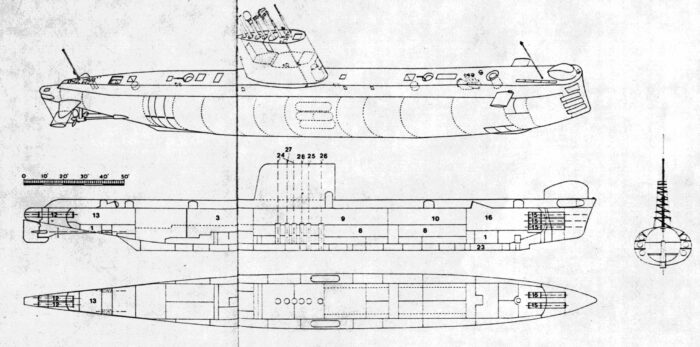
Unknown origin, from weaponsandwarfare.com,s rc below
So apart the UXW steel used as seen above, these boats ended at 2,450 tonnes submerged, which was not huge and still sported a well separated upper deck with a prow unlike the all-blended design of the Type XXI. The conning tower was however new, and shaped as a “sail”, tall but with a step. Its aft part was well rounded and shaped like a wing trailing edge, well rounded and profiled. The utility masts and snorkel were all placed in wells with fully shut features to blend in the sail as well. The only “stiking” elements was mounted on the perculiar prow, ideal for surface running but very different from the nose of a Type XXI: It was the sonar radome. More so, they were initially designed with a deck gun, but it was dropped when blueprints were delivered. Despite a moderate stramlining, they still ended far more silent than any previous British subs, or any sub at the time in 1958 anyway thanks to several measure (see below).
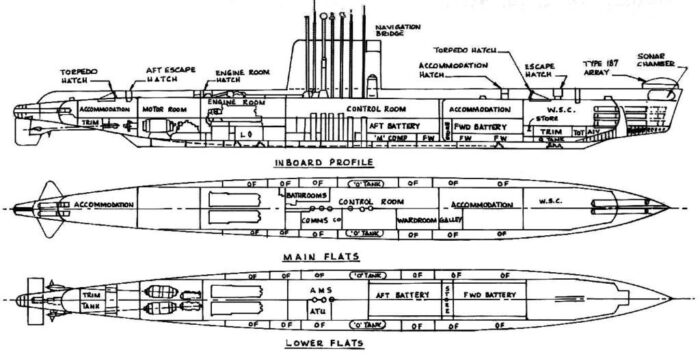
Internal cutout of the very close Oberon class, even quieter.
Powerplant
The Porpoise class came out with a “classic” powerplant, albeit of a brand new model that was more powerful. They comprised two Admiralty 16-cylinder ASR 1 Standard range diesel generators rated for 1,650 hp (1,230 kW) each. The shafts were activated through two English Electric main motors, 6,000 hp (4,500 kW) each, and the battery capacity was almost doubled thans to the extra beam and depth of the pressure hull. The two sets of batteries were linked in series to give 880V for short bursts of high speed.
They had been designed with a top speed of 18 knots (33 km/h; 21 mph) but max speed was kept at 17 knots (31 km/h; 20 mph) or 16 knots (30 km/h; 18 mph) as to made them more discreet, silenced propellers were used. That sacrifice was worth it and that quieter running was felt to be a positive trade-off. In fact, The Porpoise class were exceptionally quiet underwater. Among NATO subs they were certainly considered so, far more even than Soviet Whiskeys. Engineers indeed not only worked on better propellers, but also on early designs to mounting the machinery on suspended systems to avoid any vibrations to be transmitted to the hull. The propeller designed at the time was tested in order to prevent cavitation.
These “silenced propellers” still had an acoustic signature, a distinctive resonant “singing”. But it was not attributed to a submarine at the time. Still, this too was eliminated by cutting grooves into the propellers blased as well as injecting with a damping filler. HMD Rorqual passed the US patrols off New York was able to surface undetected off the Statue of Liberty to showcase this. The other benefit of this silent running was to magnify the effectiveness of their sonar equipment, devoid of self-parasiting noises.
Armament
Each of the Porpoise clas sboat had eight 21 inch (533 mm) torpedo tubes, six in the bow, two in the stern, which was generous but less than the excessive T (10 tubes) and A class (8 tubes initialy). The reasoning was that torpedo tubes were a potential noise source, take a lot of internal space, and that more so, a new generation of torpedoes was worked on which did not required to send “broadsides” at the target in a “spray and prey” fashion. The 1956 design planned up to 30 Mark 8 or Mark 20 and 23 torpedoes to be carried. These were the first generation, but in the 1970s they received the new and revolutionary Mark 24 Tigerfish torpedo.
Mark 8 Torpedo
The good old burner cycle torpedo, entering service in 1927. A stable of sub operations in WW2, they were still in service with large stockpiles postwar. They however has a straight course with classic settings, nothing revolutionary but were available in quantities and could be used on less important targets when in patrol. The Mod 4 was an evolution of WW2. This was one of these thant was operated by HMS Conqueror and sank the Argentine cruiser General Belgrano.
⚙ specifications Mark VIII mod 4 |
|
| Weight | 3,452 lbs. (1,566 kg) |
| Dimensions | 259 in (6.579 m) |
| Propulsion | Burner-cycle |
| Range/speed setting | 5,000 yards (4,570 m)/45.5 knots or 7,000 yards (6,400 m)/41 knots |
| Warhead | 805 lbs. (365 kg) Torpex |
| Guidance | Straight, initial setting |
It’s possible they tested the HPT running 21″ (53.3 cm) Mark 12 (Ferry) torpedo from 1952, but they were considered dangerous and not adopted eventually. The WW2 “S” class submarine HMS Sidon loaded two Mark 12 torpedoes on 16 June 1955 for a test firing and one of these torpedoes exploded in her No. 3 tube, killing 13. The submarine was a write off as was this model.
Mark 20 Torpedo
This was the first British passive homing torpedo. The model adopted was the Mark 20 S, entering service in 1955. So they were already in use with the T and A conversions. The surface version was abandoned because its preset attack data system was unreliable, leaving only sublarine variants. The Mark 20 C was a successor developed in the early 1960s and replaced by Tigerfish in the 1980s.
⚙ specifications Mark 20S TORPEDO |
|
| Weight | 1,810 lbs. (821 kg) |
| Dimensions | 254.5 in (6.464 m) |
| Propulsion | Battery |
| Range/speed setting 20S | 12,000 yards (11,000 m)/20 knots |
| Range/speed setting 20C | 7,000 yards (6,600 m)/23 knots |
| Warhead | 196 lbs. (89 kg) |
| Max depth | |
| Guidance | |
Mark 23 Torpedo
Called the “grog”, this was a modified Mark 20 with wire-guidance system between the battery compartment and afterbody which development started in the 1953, tested in 1955 but not in service before 1966, not even fully operational until 1971. It was an interim torpedo before the Mark 24 Tigerfish.
⚙ specifications TORPEDO |
|
| Weight | 2,000 lbs. (907 kg) |
| Range/speed setting | 8,750 yards (8,000 m) at 28 knots |
| Guidance | Wire guided |
Sensors
Type 1002 radar: Operating in X-band, surface+air warning and ranging. Type AKU(3) or AKS(2) antenae for 360° or sector mode. Displays on a PPI scope and A-scope for range finding. FRQ 9 650 MHz ± 50 MHz (X-band), pulse repetition frequency (PRF): 400 to500 Hz or 2 000 to 2 500 Hz, pulsewidth 1 µs or 0.2 µs, peak power 30 kW.
Type 187 sonar: 1953 model, for Active-Passive attack. Used a dome housing on the prow.
Type 2007 sonar: Hull mounted long-range passive sonar, upgraded from the Oberon class.
Type 2009 sonar: Underwater acoustic recognition system.
UAH ECM suite: Designed by L3Harris, no more data.

Mike1978russia profile, enhanced in 3D rendition by the author, CC.
⚙ specifications |
|
| Displacement | 2,080 tons surfaced, 2,450 tons submerged |
| Dimensions | 290 ft x 26 ft 7 in x 18 ft (88 x 8.10 x 5.5 m) |
| Propulsion | 2× shafts Admiralty diesels 1,650 hp (1,230 kW), 2× EE main motors, 6,000 hp (4,500 kW) |
| Speed | 12 knots (22 km/h; 14 mph) surfaced, 17 knots (31 km/h; 20 mph) submerged |
| Range | 9,000 nmi (17,000 km; 10,000 mi) at 12 kn (22 km/h; 14 mph) |
| Armament | 8 × 21 inch (533 mm) torpedo tubes, 6 bow, 2 stern, see notes |
| Sensors | Type 1002 radar, type 186, type 187, type 2007 sonars, UAH ECM suite |
| Crew | 71 |
Career of the Porpoise class
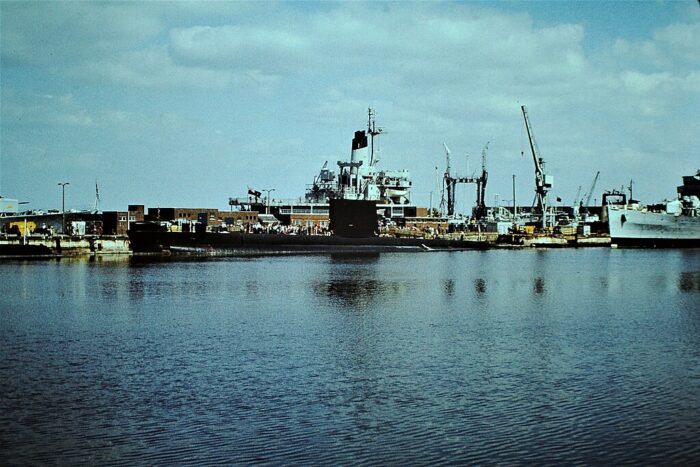
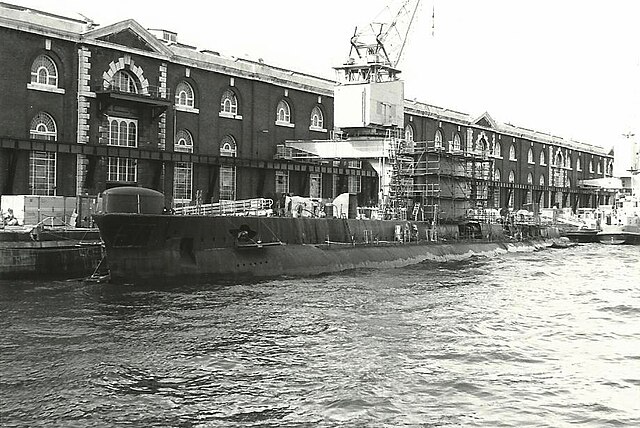
HMS Sealion at Portsmouth Nav Day 1980.
 HMS Porpoise (S01)
HMS Porpoise (S01)
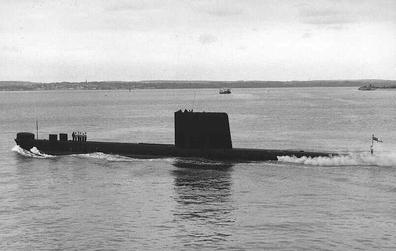 Porpoise was laid down on 15 June 1956 (ordered on 25 April 1956), built by Vickers at Barrow-in-Furness, launched on 25 April 1956 and commissioned on 17 April 1958. No full logs for now.
Porpoise was laid down on 15 June 1956 (ordered on 25 April 1956), built by Vickers at Barrow-in-Furness, launched on 25 April 1956 and commissioned on 17 April 1958. No full logs for now.
However on 18 October 1963 she suffered superficial damage while off Portsmouth after colliding with the aircraft carrier HMS Centaur. On 1 January 1969 she became Entangled in the nets of the French trawler Belle Poule. On 18 April 1982 she became entangled in the fishing nets of the Irish trawler Sharelga, which after travelling backwards 2 miles and over twenty minutes, becale flooded, capsized and sank. Obviously HMS Portpoise’s crew had no idea of what was going on and this cause quite a stir in Ireland at the time.
She was decommissioned in 1982. Mothballed, she was sunk as a target in 1985 in torpedo trials, painted bright red. She was used before that as a training target and by 1979 she was modified as her casing, ballast tanks and vents were reinforced to resist the impact of unarmed torpedoes. The external coating was designed to leave mark on the impact point for more precise accuracy data researches. In 2000, a glacier in East Greenland was named after her and she had as captains Lieutenant Commander G R H Lloyd-Williams RN until 1966, then Lieutenant Commander MJ Syme RN from 1977, Lieutenant Commander J L Milnes in 1978-79 and between 1979 and 1981, Lt Commander N S R Kilgour CB.
 HMS Rorqual (S02)
HMS Rorqual (S02)
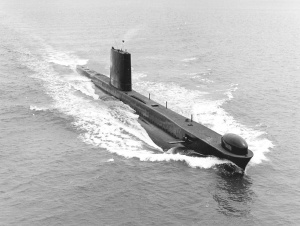 Rorqual was built by Vickers at Barrow-in-Furness. She was laid down on 15 January 1955, launched on 15 December 1956 and completed on 24 October 1958. In 1958, Rorqual she experienced a fire.
Rorqual was built by Vickers at Barrow-in-Furness. She was laid down on 15 January 1955, launched on 15 December 1956 and completed on 24 October 1958. In 1958, Rorqual she experienced a fire.
In February 1960, she made her first patrols in the Mediterranean, stopping at La Spezia and Nice and returnd to Faslane. In 1963, she was caught in a trawler’s net. In 1966 there was an explosion on board while under way for Singapore, off Mozambique, killing one junior rate and injured the chief of the watch, later dying ashore at Inhambane. In 1969, she rammed the moored minesweeper USS Endurance (MSO-435) while docking at River Point pier in Subic Bay (Philippines). Endurance needed repairs. This happened under Lt.Cdr Gavin Menzies (who retired in 1967 and becale infamous for his book “1421: The Year China Discovered America”. The submarine won the SOCA Efficiency trophy in 1973. She was decommissioned at Plymouth on 5 May 1977 and BU shortly after.
 HMS Narwhal (S03)
HMS Narwhal (S03)
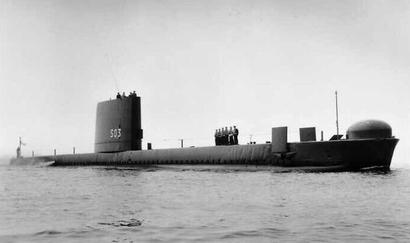 Narwhal was laid down on 15 March 1956 and launched on 25 October 1957, completed in May 1959. She was Built by Vickers at Barrow-in-Furness. On 4 April 1960 she ran aground at the entrance to Campbeltown Loch in Scotland, but was refloated the on the 5th and repaired. She briefly appeared in the 1961 film ‘The Day Of The Triffids’. In 1970 she was present at Portsmouth Navy Days. In October 1976, she took part in Operation Brisk with the SSN HMS Sovereign, a cruise under ice. Sovereign later surfaced at the North Pole.
Narwhal was laid down on 15 March 1956 and launched on 25 October 1957, completed in May 1959. She was Built by Vickers at Barrow-in-Furness. On 4 April 1960 she ran aground at the entrance to Campbeltown Loch in Scotland, but was refloated the on the 5th and repaired. She briefly appeared in the 1961 film ‘The Day Of The Triffids’. In 1970 she was present at Portsmouth Navy Days. In October 1976, she took part in Operation Brisk with the SSN HMS Sovereign, a cruise under ice. Sovereign later surfaced at the North Pole.
Narwhal was decommissioned on 10 February 1977 but mothballed. On 2 June 1980 she was sunk as target off Portland, then raised in a salvage exercise on 26 June 1980 by the Swedish heavy-lift ship Hebe III, and scuttled as a target again on 3 August 1985 in the English Channel.
 HMS Grampus (S04)
HMS Grampus (S04)
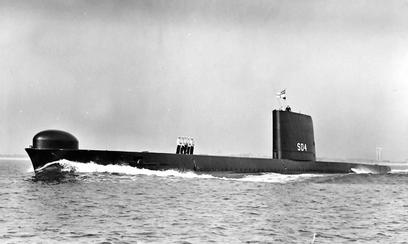 HMS Grampus was laid down on 16 April 1955, launched on 30 May 1957 at Cammell Laird at Birkenhead. She was first commissioned in her class on 19 December 1958. On 1 April 1963 she was back at Gisport after three weeks under the polar icecap, looking for holes to surface. Her upper hull and sail were damaged by ice. In 1965 she refitted in Devonport and under Lieutenant-Commander J F Woodward from 1964. On 11 January 1968, she was caught into the nets of the French trawler Fomalhaut in the English Channel. She surfaced and both crews spent three hours disentangling the nets. The same year, she was versed into the 1st Submarine Squadron at HMS Dolphin establushment,and took part in that year’s Navy Days in Portsmouth.
HMS Grampus was laid down on 16 April 1955, launched on 30 May 1957 at Cammell Laird at Birkenhead. She was first commissioned in her class on 19 December 1958. On 1 April 1963 she was back at Gisport after three weeks under the polar icecap, looking for holes to surface. Her upper hull and sail were damaged by ice. In 1965 she refitted in Devonport and under Lieutenant-Commander J F Woodward from 1964. On 11 January 1968, she was caught into the nets of the French trawler Fomalhaut in the English Channel. She surfaced and both crews spent three hours disentangling the nets. The same year, she was versed into the 1st Submarine Squadron at HMS Dolphin establushment,and took part in that year’s Navy Days in Portsmouth.
In 1972 she sailed with USS Tigrone in a joint oceanographic operation, eastern Atlantic. She was reclassed as a Harbour training ship between 1976 and 1979 and decommissioned the same year, mothballed, then reassigned as target. She sank on 18 September 1980 in Loch Fyne as being towed as a sonar target, still is there for divers to explore under 120 m.
 HMS Finwhale (S05)
HMS Finwhale (S05)
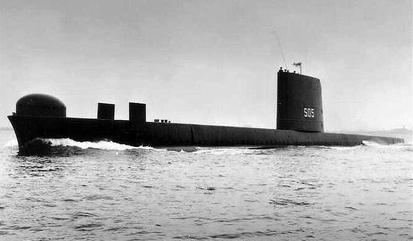 HMS Finwhale was laid down at Cammell Laird at Birkenhead 18 September 1956, launched on 21 July 1959 and completed, commissioned on 19 August 1960. As this occasion she made an under ice cruise and went further than any other submarine at the time. She was recommissioned on 27 January 1964 after a refit and by March 1965 made a second Arctic patrol making a foray over 95 miles under ice. She tok part in Portsmouth Navy Days in 1965 and 1966 but was also deployed in Far East notably over the contested Indonesian waters and carried a 20mm AA Oerlikon deck gun.
HMS Finwhale was laid down at Cammell Laird at Birkenhead 18 September 1956, launched on 21 July 1959 and completed, commissioned on 19 August 1960. As this occasion she made an under ice cruise and went further than any other submarine at the time. She was recommissioned on 27 January 1964 after a refit and by March 1965 made a second Arctic patrol making a foray over 95 miles under ice. She tok part in Portsmouth Navy Days in 1965 and 1966 but was also deployed in Far East notably over the contested Indonesian waters and carried a 20mm AA Oerlikon deck gun.
She was used as a harbour training vessel between 1979 and 1987, recommissioned this year, and towed for scrapping in Spain on 28 March 1988.
 HMS Cachalot (S06)
HMS Cachalot (S06)
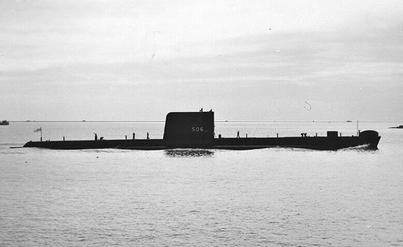 Cachalot was laid down at Scotts at Greenock on 1 August 1955, launched on 11 December 1957 and completed on 1 September 1959. No logs published. She had a relatively uneventful career. In 1977 she attended the Silver Jubilee Fleet Review off Spithead for the Queen. She was sold on 12 November 1979 for BU at Blyth.
Cachalot was laid down at Scotts at Greenock on 1 August 1955, launched on 11 December 1957 and completed on 1 September 1959. No logs published. She had a relatively uneventful career. In 1977 she attended the Silver Jubilee Fleet Review off Spithead for the Queen. She was sold on 12 November 1979 for BU at Blyth.
 HMS Sealion (S07)
HMS Sealion (S07)
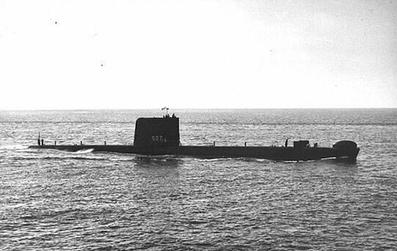 Sealion was laid down on 5 June 1958, launched 31 December 1959 at Cammell Laird at Birkenhead and completed on 25 July 1961. In 1963 she carried our surveillance against a Soviet naval exercise until detected by Soviet warships, forced to surface. Between 1976 and 1977 she was commanded by J K Boyle. She was present at the 1977 Silver Jubilee Fleet Review. By late 1986–1987, still in service, she was deployed to the South Atlantic and patrolled around the Falkland before stopping in Chile and back via the Caribbean. This ws her last cruise. When entering port she flew the traditional Jolly Roger, as she likely took part in a special forces operation. Paid off in December 1987, she was sold to an Education Trust for inner-city youngsters callled “Inter Action” anchored in Chatham on 22 June 1988. Ultimately she was however sold for BU in 1990.
Sealion was laid down on 5 June 1958, launched 31 December 1959 at Cammell Laird at Birkenhead and completed on 25 July 1961. In 1963 she carried our surveillance against a Soviet naval exercise until detected by Soviet warships, forced to surface. Between 1976 and 1977 she was commanded by J K Boyle. She was present at the 1977 Silver Jubilee Fleet Review. By late 1986–1987, still in service, she was deployed to the South Atlantic and patrolled around the Falkland before stopping in Chile and back via the Caribbean. This ws her last cruise. When entering port she flew the traditional Jolly Roger, as she likely took part in a special forces operation. Paid off in December 1987, she was sold to an Education Trust for inner-city youngsters callled “Inter Action” anchored in Chatham on 22 June 1988. Ultimately she was however sold for BU in 1990.
 HMS Walrus (S08)
HMS Walrus (S08)
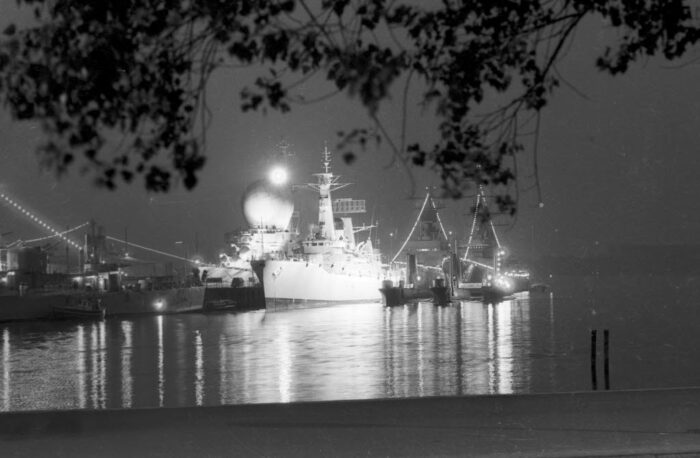
HMS Walrus at the Kiel week in 1970
HMS Walrus was Laid down at Scotts at Greenock on 12 February 1958, launched 22 September 1959 and commissioned on 10 February 1961. During exercises with HMS Ark Royal (R09) her practice torpedo becoming embedded in her casing. She had a 18-month refit at Devonport and was rcommissioned for a third and last time on 3 December 1969. In 1970 she took part in Portsmouth Navy Days and in 1977, the Silver Jubilee Fleet Review off Spithead. She was sold in 1987 to Seaforth, refitted for resale to Egypt but the deal fell through and instead she was resld for BU to Grimsby in 1991.
Read More/Src
Books
Rebuilding the Royal Navy : Warship Design Since 1945, D. K. Brown and George Moore, Chatham Publishing, 2003
Conway’s all the world’s fighting ships 1947-95
Links
battleships-cruisers.co.uk/
https://submarinersassociation.co.uk/
britsub.x10.mx
navsource.org/archives
navypedia.org/
navweaps.com/
rnsubs.co.uk/
weaponsandwarfare.com/
www.navygeneralboard.com/
commons.wikimedia.org/
Videos
Model Kits
on scalemates.com
review of the kit starling models 1:700 by modellmarine.de
3D
Nope.

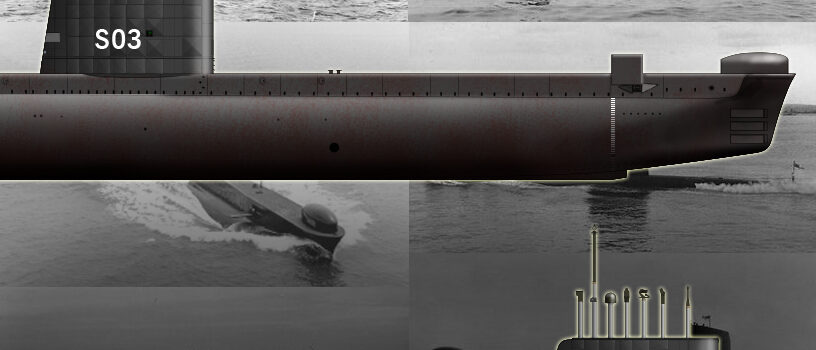

 Latest Facebook Entry -
Latest Facebook Entry -  X(Tweeter) Naval Encyclopedia's deck archive
X(Tweeter) Naval Encyclopedia's deck archive Instagram (@navalencyc)
Instagram (@navalencyc)





 French Navy
French Navy Royal Navy
Royal Navy Russian Navy
Russian Navy Armada Espanola
Armada Espanola Austrian Navy
Austrian Navy K.u.K. Kriegsmarine
K.u.K. Kriegsmarine Dansk Marine
Dansk Marine Nautiko Hellenon
Nautiko Hellenon Koninklije Marine 1870
Koninklije Marine 1870 Marinha do Brasil
Marinha do Brasil Osmanlı Donanması
Osmanlı Donanması Marina Do Peru
Marina Do Peru Marinha do Portugal
Marinha do Portugal Regia Marina 1870
Regia Marina 1870 Nihhon Kaigun 1870
Nihhon Kaigun 1870 Preußische Marine 1870
Preußische Marine 1870 Russkiy Flot 1870
Russkiy Flot 1870 Svenska marinen
Svenska marinen Søværnet
Søværnet Union Navy
Union Navy Confederate Navy
Confederate Navy Armada de Argentina
Armada de Argentina Imperial Chinese Navy
Imperial Chinese Navy Marinha do Portugal
Marinha do Portugal Mexico
Mexico Kaiserliche Marine
Kaiserliche Marine 1898 US Navy
1898 US Navy Sovietskiy Flot
Sovietskiy Flot Royal Canadian Navy
Royal Canadian Navy Royal Australian Navy
Royal Australian Navy RNZN Fleet
RNZN Fleet Chinese Navy 1937
Chinese Navy 1937 Kriegsmarine
Kriegsmarine Chilean Navy
Chilean Navy Danish Navy
Danish Navy Finnish Navy
Finnish Navy Hellenic Navy
Hellenic Navy Polish Navy
Polish Navy Romanian Navy
Romanian Navy Turkish Navy
Turkish Navy Royal Yugoslav Navy
Royal Yugoslav Navy Royal Thai Navy
Royal Thai Navy Minor Navies
Minor Navies Albania
Albania Austria
Austria Belgium
Belgium Columbia
Columbia Costa Rica
Costa Rica Cuba
Cuba Czechoslovakia
Czechoslovakia Dominican Republic
Dominican Republic Haiti
Haiti Hungary
Hungary Honduras
Honduras Estonia
Estonia Iceland
Iceland Eire
Eire Equador
Equador Iran
Iran Iraq
Iraq Latvia
Latvia Liberia
Liberia Lithuania
Lithuania Mandchukuo
Mandchukuo Morocco
Morocco Nicaragua
Nicaragua Persia
Persia San Salvador
San Salvador Sarawak
Sarawak Uruguay
Uruguay Venezuela
Venezuela Zanzibar
Zanzibar Warsaw Pact Navies
Warsaw Pact Navies Bulgaria
Bulgaria Hungary
Hungary

 Bundesmarine
Bundesmarine Dutch Navy
Dutch Navy Hellenic Navy
Hellenic Navy Marina Militare
Marina Militare Yugoslav Navy
Yugoslav Navy Chinese Navy
Chinese Navy Indian Navy
Indian Navy Indonesian Navy
Indonesian Navy JMSDF
JMSDF North Korean Navy
North Korean Navy Pakistani Navy
Pakistani Navy Philippines Navy
Philippines Navy ROKN
ROKN Rep. of Singapore Navy
Rep. of Singapore Navy Taiwanese Navy
Taiwanese Navy IDF Navy
IDF Navy Saudi Navy
Saudi Navy Royal New Zealand Navy
Royal New Zealand Navy Egyptian Navy
Egyptian Navy South African Navy
South African Navy






























 Ukrainian Navy
Ukrainian Navy dbodesign
dbodesign
Like it or not but the XXI WAS INDEED A WUNDERWAFFE! had it and other German designs not existed then the rest of the world would be 50 years behind what it currently is..
Yet another element copied from Germany was ALBRICHT which was the world’s first Anechoic coating fir a submarine and it was quite effective
Britain had a jet turbine designed by Whittle THAT NEVER WORKED PROPERLY AND WAS MASSIVELY FUEL THIRSTY. Whereas the Junkers designs were significantly superior (yes they were made with inferior steels but they were still better). As a matter of fact every jet turbine designed post 1949 was based up BMW, JUNKERS OR DAIMLER DESIGNS NOT WHITTLE
btw you people should be required to proof read your entries on this site because as of lately every article has been rife with errors in punctuation.
I served on Cachalot and feel quite agrieved of her service as realitivly uneventful!!! Our crew delivered sbs to the shores of Ireland during covert Opps, and gun running watches of the coast during the mid 70s. Also took big hits from the Russians while doing Sneekies on the Russian aircraft carrier ” kiev” off Tripoli!!!! worrying times for an 18 year old.BUT STILL PROUD TO HAVE SERVED. NO WONDER NO LOGS PUBLISHED!!!????
Thx for the input, that’s why there is “relative”… I mean the boat did not suffered collision, severe grounding or nuclear accident so…